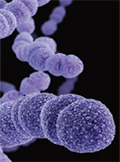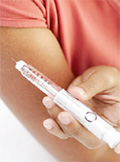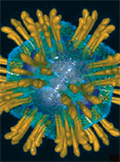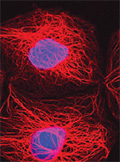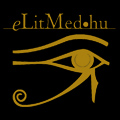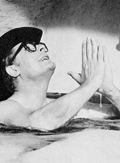The eLitMed.hu medical portal uses computer cookies for convenient operation. Detailed information can be found in the Cookie-policy.
Lege Artis Medicinae - 2014;24(04)
Content
[Antibody deficiencies, investigation, therapy]
[Inborn antibody deficiencies represent the most common primary immunodeficiency diseases. This heterogeneous group of disorders is characterised by insufficient antibody production resulting from a genetic defect of B cell differentiation or from abnormal interactions between B and T cells. The clinical manifestations are recurrent, often severe upper and lower respiratory tract infections, but chronic diarrhea and autoimmune diseases might also occur. Timely diagnosis and therapy significantly decrease morbidity, thus increasing life expectancy and improve quality of life.]
[Treatment of clubfoot with the Ponseti method]
[INTRODUCTION - Congenital clubfoot is a severe developmental disorder. Without treatment, only the lateral border of the foot can be loaded and the sole faces the contralateral side. Good results can usually be achieved with early redression by serial casting (generally from the first week after birth) followed by extensive surgery at age six months (Achilles tendon lengthening, capsulotomy of the talo-crural and subtalar joints). The above procedure has been revolutionised by the method described by Ignacio Ponseti based on his own experiences, which has modified the casting technique and has also radically changed the surgical intervention. In this paper we report our experiences with Ponseti’s method and draw attention to this less invasive procedure. PATIENTS AND METHODS -The essence of Ponseti’s techniqe is reposition of the talonavicular joint, for which the foot is corrected in a different way compared with previous practice. Following redression for 8-10 weeks, percutaneous complete Achilles tenotomy is performed and the foot is fixed for further three weeks. A special orthesis is worn in the following 6 months for 24 hours a day and the same ortézis is suggested for overnights afterwards. In our institution, 171 clubfeet (45 unilateral, 126 bilateral; 84 right, 87 left; 25 girls, 83 boys) were treated between 2007 and 2012. Our results were evaluated with the help of the Pirani score, which is a widely used method for assessment of clubfoot treatment. RESULTS - Results were evaluated at the beginning of the treatment, at the end of redression and after percutaneous Achilles tenotomy. Pirani scores were 4.54±1.30; 1.48±1.02 and 0.59±0.45 respectively. The average dorsal flexion of the ankle joints was 23±12 degrees. CONCLUSION - Our own observations support the good results published in the literature, therefore the less invasive Ponseti method is suggested for the primary treatment of congenital clubfoot.]
[Vaccine coverage of invasive and carried Streptococcus pneumoniae isolates in Hungary]
[Vaccination against Streptococcus pneumoniae will be mandatory for infants and children from 1 July 2014 in Hungary. Since the introduction of the conjugate vaccine against Pneumococcus, the distribution of Pneumococcus serotypes has changed significantly. Surveillance data from the National Centre for Epidemiology show that certain vaccine-type pneumococcal serotypes have almost disappeared owing to the immunization program, while other serotypes have emerged. Nowadays serotype 3 and the multiresistant 19A serotype are the most frequent causes oif invasive infections. A study analysing the nasal carriage of children attending kindergartens also confirmed the decline of vaccine- serotypes parallel to vaccination coverage and the simultaneous emergence of previously very types, such as 19A. The most recent study examining nasal carriage of children attending nursery (age < 3 years) showed that the 13-valent conjugate vaccine has efficiently decreased the carriage of serotypes 3 and 19A, verifying that the immunisation program should be continued using the vaccine providing the broadest coverage against Pneumococcus.]
[Switching from human basis-bolus insulin treatment to analog insulins, from clinical aspects]
[During treatment of patients with type 2 diabetes, early insulin treatment improves beta cell function, slows the progression of the disease and improves glycaemic values in the long term. In these cases, the strictest glycaemic target values can be achieved by basal-bolus insulin treatment. Furthermore, the development of chronic complications can be halted most effectively by normoglycaemia. It is a special task to switch from human basal-bolus insulin treatment to analog insulins. The author presents practical, clinical aspects of this switching through a case study.]
[Diagnostic challenges in our adolescent patient with lymphoma]
[OBJECTIVES - Unclassifiable B-cell lymphoma, which shows intermediate features typical for both diffuse, large B-cell lymphoma (DLBCL) and classical Hodgkin lymphoma (HL) is a novel category of diffuse, large B-cell lymphomas (DLBCL/HL), described in the WHO classification in 2008. This rare type of lymphomas presents peculiar clinical, morphological and immunophenotypical patterns, previously called gray-zone lymphomas. CASE REPORT - In December 2011 a 17- year old boy was diagnosed with mixedcellularity subtype of classical HL on the basis of left inguinal lymph node biopsy. Staging examinations revealed a IV/BXS (abdominal bulky) stage disease with unfavourable prognosis. Because of the unusally extended disease (nodal-extranodalbulky), a histological revision was performed. After a half course of ABVD chemotherapy the patient’s symptoms disappeared and the sizes of the involved lymph nodes decreased. On the basis of the histological revision, the diagnosis was changed to DLBCL/HL, so the treatment was modified to R-CHOP-14 regimen. After 3 cycles of R-CHOP-14 a complete metabolic remission (CMR) was achieved, which was confirmed by a 18FDG-PET/CT scan. Staging examinations after further 4 cycles of RCHOP- 14 therapy showed that the patient was still in CMR, but a PET-negative large mass (7×3 centimeter) still remained visible in the abdominal region. Considering this residual tumour and the agressive subtype of lymphoma the patient was referred for an autologous haemopoietic stem cell transplantation (AHSCT). After 2 cycles of R-DHAP regimen, successful CD34- positive stem cell collection was performed in August 2012. In September 2012, a RLAM-BEAM conditioning was performed followed by AHSCT. Posttransplantation 18FDG-PET/CT scan revealed further morphological regression, no symptom of the underlying disease appeared and the patient is in complete remission for 15 months. CONCLUSIONS - This case exemplifies that in case of atypical clinical findings and unusual progress of the disease it might be worthwile to re-evaluate the case and the (histological) diagnosis, which requires a close cooperation between the clinician and the pathologist.]
[The healing environment: The landscape architecture’s aspects of the psychiatric institutional gardens development]
[According to researches, the surrounding environment of the people has a significant impact on the human well-being, its perception of welfare and may influence its health condition. Even the sight of a spacious, well-maintained, healthy densely vegetated area can strengthen the human body, so it may promote patients by the healing process. On the one hand, this study aims to overview the international literatures and best practises of the healingand therapeutic gardens. Our other goal was to show the potential feasibility of the theoretical principles by preparing analysis, evaluation and a detailed conception plan for a chosen institution garden. We also formulated generally applicable design guidelines for psychiatric home garden design. This research is aimed to contribute the creation an important objective of the European Union, to achieve equal opportunities.]
1.
Clinical Neuroscience
Is there any difference in mortality rates of atrial fibrillation detected before or after ischemic stroke?2.
Clinical Neuroscience
Factors influencing the level of stigma in Parkinson’s disease in western Turkey3.
Clinical Neuroscience
Neuropathic pain and mood disorders in earthquake survivors with peripheral nerve injuries4.
Journal of Nursing Theory and Practice
[Correlations of Sarcopenia, Frailty, Falls and Social Isolation – A Literature Review in the Light of Swedish Statistics]5.
Clinical Neuroscience
[Comparison of pain intensity measurements among patients with low-back pain]1.
Clinical Neuroscience Proceedings
[A Magyar Stroke Társaság XVIII. Kongresszusa és a Magyar Neuroszonológiai Társaság XV. Konferenciája. Absztraktfüzet]2.
3.
Journal of Nursing Theory and Practice
[A selection of the entries submitted to the literary contest "Honorable mission: the joys and challenges of our profession" ]4.
Journal of Nursing Theory and Practice
[End of Life and Palliative Care of Newborns in the Nursing Context]5.
Journal of Nursing Theory and Practice
[Aspects of Occupational Health Nursing for Incurable Patients ]




